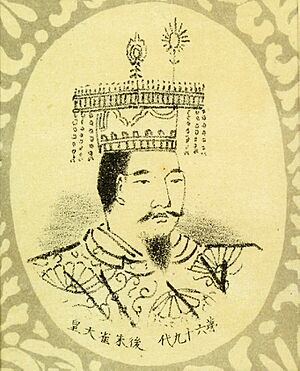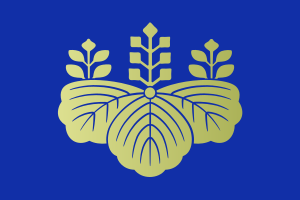Emperor Go-Suzaku facts for kids
Quick facts for kids Emperor Go-Suzaku後朱雀天皇 |
|||||
|---|---|---|---|---|---|
 |
|||||
| Emperor of Japan | |||||
| Reign | May 15, 1036 – February 5, 1045 | ||||
| Coronation | August 4, 1036 | ||||
| Predecessor | Go-Ichijō | ||||
| Successor | Go-Reizei | ||||
| Born | 14 December 1009 Heian Kyō (Kyōto) |
||||
| Died | 7 February 1045 (aged 35) Higashi-sanjō Tei (東三条第), Heian Kyō (Kyōto) |
||||
| Burial | Enjō-ji no misasagi (円乗寺陵) (Kyōto) | ||||
| Spouse |
Teishi
(m. 1027)Fujiwara no Genshi
(m. 1037; died 1039) |
||||
| Issue |
|
||||
|
|||||
| House | Yamato | ||||
| Father | Ichijō | ||||
| Mother | Fujiwara no Shōshi | ||||
Emperor Go-Suzaku (後朱雀天皇, Go-Suzaku-tennō, December 14, 1009 – February 7, 1045) was the 69th emperor of Japan. He ruled from 1036 to 1045.
His name, Go-Suzaku, means "Later Emperor Suzaku." The word "Go-" in Japanese can mean "later" or "second." So, he is sometimes called "Suzaku the Second."
Contents
Life of Emperor Go-Suzaku
Before he became emperor, his personal name was Atsunaga-shinnō.
His father was Emperor Ichijō. His mother was Fujiwara no Shōshi. She was the daughter of a powerful leader named Fujiwara no Michinaga. Go-Suzaku was the younger brother of Emperor Go-Ichijō, who was emperor before him.
Emperor Go-Suzaku had five empresses and seven children.
Important Events During His Reign
- May 15, 1036: Emperor Go-Ichijō, Go-Suzaku's older brother, passed away. Go-Suzaku then became the new emperor. This is called senso, which means receiving the succession.
- 1036: Emperor Go-Suzaku officially took the throne in a ceremony called sokui.
- February 5, 1045: Emperor Go-Suzaku decided to step down from his role as emperor. This is called abdication.
- February 7, 1045: Just two days after stepping down, the former Emperor Go-Suzaku became a Buddhist monk. He passed away on the same day at the age of 37. He had been emperor for nine years.
The exact place where Emperor Go-Suzaku was buried is not known today. However, he is honored at a special Shinto shrine in Kyoto. This place is called Enjō-ji no misasagi.
Go-Suzaku is one of the "Seven Imperial Tombs" at Ryōan-ji Temple in Kyoto. The mound that honors him is called Shu-zan.
His burial place was very simple when he died. Later, in the 1800s, Emperor Meiji ordered these imperial burial sites to be restored.
Emperor Go-Suzaku's wife, Teishi Nai-shinnō, is also buried nearby.
Important Court Officials
Kugyō is a special name for the most powerful men who worked for the Emperor of Japan long ago. Even when the emperor's power was not very strong outside the palace, these officials were still very important.
Usually, only three or four men held these top positions at one time. They were often from noble families and had a lot of experience. During Go-Suzaku's time, some of these top officials included:
Eras During His Rule
In Japan, years are often grouped into special periods called nengō or era names. Here are the eras during Emperor Go-Suzaku's reign:
His Family: Wives and Children
Emperor Go-Suzaku had several wives and many children.
Empress (kōgō): Imperial Princess Teishi (禎子内親王; 1013–1094), who was the third daughter of Emperor Sanjō.
- First Daughter: Imperial Princess Nagako/Ryōshi (良子内親王, 1029–1077) – She served as a special priestess (Saiō) at Ise Shrine.
- Second Daughter: Imperial Princess Yoshiko/Kenshi (娟子内親王, 1032–1103) – She served as a special priestess (Saiin) at Kamo Shrine. Later, she married Minamoto Toshifusa.
- Second Son: Imperial Prince Takahito (尊仁親王) – He later became Emperor Go-Sanjo.
Empress (chūgū): Fujiwara no Genshi (藤原嫄子; 1016–1039), who was the adopted daughter of Fujiwara no Yorimichi.
- Third Daughter: Imperial Princess Sukeko/Yūshi (祐子内親王; 1038–1105)
- Fourth Daughter: Imperial Princess Miwako/Baishi (禖子内親王; 1039–1096) – She served as a special priestess (Saiin) at Kamo Shrine.
Crown Princess (died before Emperor's accession): Fujiwara no Yoshiko (藤原嬉子; 1007-1025), the sixth daughter of Fujiwara no Michinaga.
- First Son: Imperial Prince Chikahito (親仁親王) – He later became Emperor Go-Reizei.
Consort (Nyōgo): Fujiwara no Nariko/Seishi (藤原生子; 1014–1068), the eldest daughter of Fujiwara no Norimichi.
Consort (Nyōgo): Fujiwara no Nobuko/Enshi (藤原延子; 1016–1095), the second daughter of Fujiwara no Yorimune.
- Fifth Daughter: Imperial Princess Masako/Seishi (正子内親王; 1045–1114) – She served as a special priestess (Saiin) at Kamo Shrine.
See also
 In Spanish: Go-Suzaku Tennō para niños
In Spanish: Go-Suzaku Tennō para niños
- Emperor of Japan
- List of Emperors of Japan
- Imperial cult
| Regnal titles | ||
|---|---|---|
| Preceded by Emperor Go-Ichijō |
Emperor of Japan: Go-Suzaku 1036–1045 |
Succeeded by Emperor Go-Reizei |


